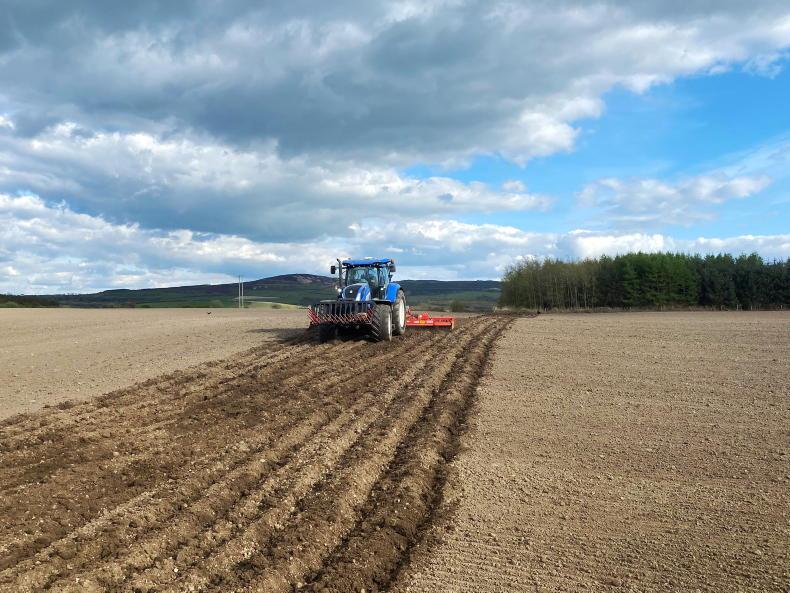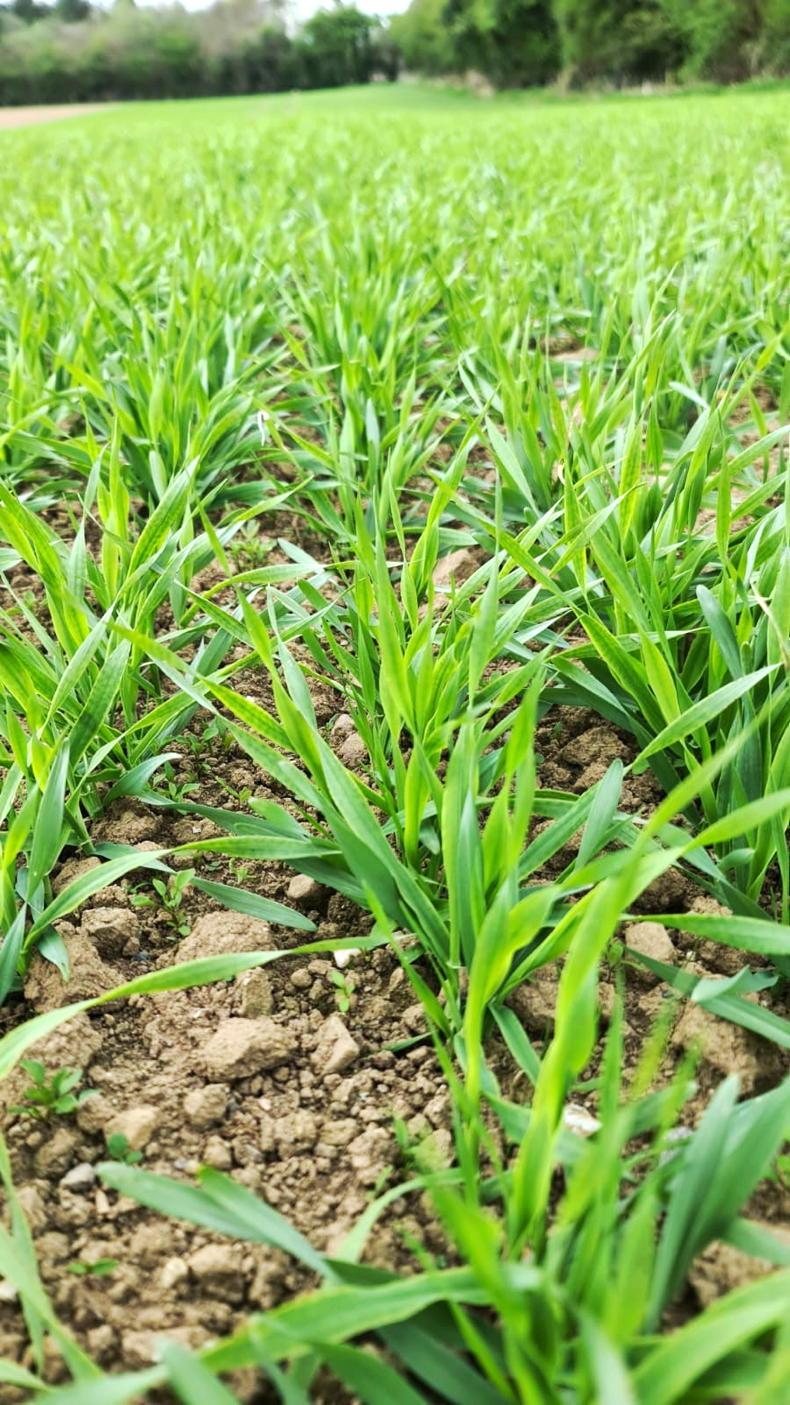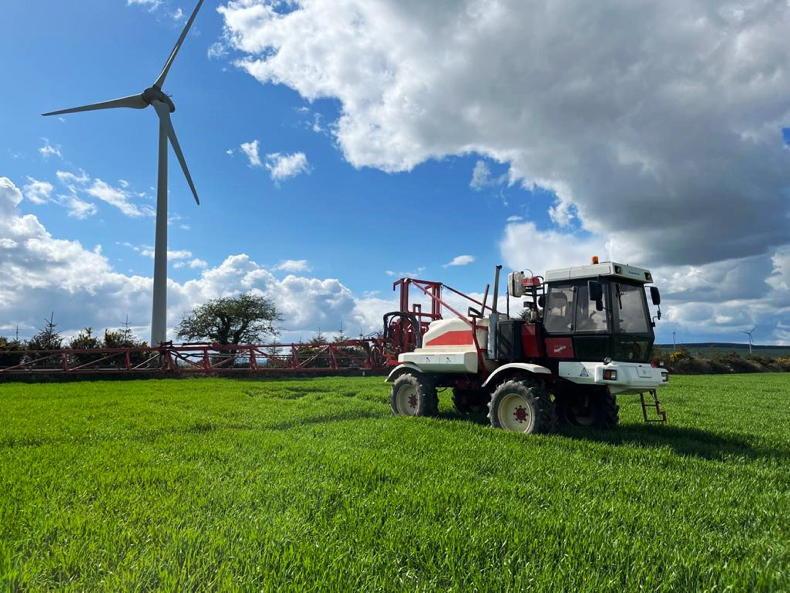The weather didn’t play ball in Donegal for most of April. Shortly after talking to Michael last, wet and cold conditions returned and field conditions deteriorated.
However, things turned around after Easter and the weather settled. Ground soon dried out again and field work restarted.
When talking to Michael this week, he still had some stubbles to plough. He is applying cattle manure on all of his stubble ground, aiming to supply more P and K from organic sources this year.
Spring sowing kicked off on 24 April. He started with Splendor spring malting barley sown at a rate of 185kg/ha. The ground was ploughed, power-harrowed and 370kg/ha of 10.5.25 + S was applied before sowing and rolling.
Michael finished sowing the crop over two days. He still has an amount of Prospect spring feed barley to sow. This is destined for ground which is just out of ley and is due to receive lime at 2t/ac before cultivating and drilling.

Michael cultivating ahead of sowing spring barley.
He is also sowing Isobel spring oats this year which will be drilled at a rate of 185kg/ha but will likely receive less P and K.
Michael is aiming to bring his malting and feed barley crops up to 130kg N/ha and his spring oats up to 106kg N/ha.
Winter barley
His Vessel winter malting barley is looking very good and has now been brought up to 162kg N/ha. The crops received their first PGR on 16 April consisting of Opmus at 0.7l/ha and are due another one shortly. They also received a T1 fungicide of Azoxystar (0.6l/ha) and Prostar (0.6l/ha) in the same tank. Michael also added liquid nutrients into the tank.
His Saki winter wheat received its main split of nitrogen last week. This was slightly later than planned but field conditions where too poor to travel on for much of April. The crops did look hungry, however, so he added a foliar feed into the tank when applying its T1 of Elatus Era (1l/ha). The crop received another 112kg/ha last Friday.
There was very heavy rain on Easter Sunday in Laois, explains Seamus, but there has been nothing since.
The return of an easterly wind quickly dried out the land and he explained that the surface of some fields have now capped. While no crops are currently suffering from lack of moisture, a shower of rain would be welcome.
He has had to hold off on top-dressing some of his spring barley as he doesn’t want to apply it when there’s no moisture to help with crop uptake. While the weather has been cold and harsh, crops are still developing. Most of his spring barley crops are now at the two- to three-leaf stage. The field which was drilled with an Amazone combi seed and fertiliser drill on demonstration looks much better than the rest, he says. All crops will be brought up to around 125kg N/ha except for crops following beet, which will be brought to 106kg N/ha.

Seamus spring barley crops which were drilled using the combi-drill are looking very well.
Seamus has yet to apply a spring herbicide but is considering Cameo Max and Cleave to target broadleaf weeds. He will also spray for wild oats at a later stage and he intends on applying no aphicide this year.
Beet
Seamus started sowing fodder beet on 16 April. This year he is growing Enermax and Bangor. He ploughs, discs and levels, applies fertiliser and power harrows before drilling. He applied either farmyard manure or slurry to the ground as well as 800kg/ha of 8.5.18.
He says conditions were fantastic when drilling but he is now hoping for some rain to soften the ground before the crops emerge.
Electrum, Vessel and Tardis winter barley crops are also looking very good. Seamus says that the crops have rushed through their growth stages over the past two weeks. All crops have been brought up to 150kg N/ha. As a result, he didn’t apply a T0 fungicide this year. Instead, on 12 April he applied a T1 consisting of Mandarin (0.5l/ha) as well as Moddus (0.3l/ha). The flag leaf is now out and he will soon apply a T2.
It has also been very dry in Wexford over the past month. The drying easterly wind meant that conditions where not very kind for crop growth and it was tricky to find a window to spray or apply fertiliser. Like many areas, some rain would be welcomed at this stage.
Spring crops have been slow to develop due to the harsh conditions. Patrick says that if growth doesn’t start soon, it could turn out to be a late year.

Patrick applying a T1 onto winter barley.
His winter crops are developing well, however, and Patrick thinks this is down to a better structured and deeper root system.
Spring barley
He hasn’t applied any herbicides yet on his spring barley crops as there isn’t enough moisture in the crop.
Patrick says there hasn’t been a big flush of weeds due to the dry conditions. When moisture does arrive, he will target the volunteer oilseed rape and resistant corn marigold which is problematic in some fields.
His spring crops have all received their top dressing. He has brought his malting barley crop up to 137kg N/ha while his roasting crops were brought up to 150kg N/ha.
He will continue to assess the risk of BYDV in his crops before deciding whether or not to apply an aphicide. He is very happy with his Lynx spring beans. There are no signs of weevil damage and he got good weed control with Nirvana. Patrick may have to follow up for wild oats, however.
Winter crops
His Joyau and Tardis winter barley crops are developing well despite the dry conditions. The crops were brought up to 200kg N/ha and all of the nitrogen appears to be washed in. As a result, the crops are green and lush in colour. There appears to be no sign of BYDV in his crops despite reports of the virus in the area. No aphicide was applied onto his winter barley.
His silage ground is closed off and grass covers are developing well despite growth being slow.
The weather didn’t play ball in Donegal for most of April. Shortly after talking to Michael last, wet and cold conditions returned and field conditions deteriorated.
However, things turned around after Easter and the weather settled. Ground soon dried out again and field work restarted.
When talking to Michael this week, he still had some stubbles to plough. He is applying cattle manure on all of his stubble ground, aiming to supply more P and K from organic sources this year.
Spring sowing kicked off on 24 April. He started with Splendor spring malting barley sown at a rate of 185kg/ha. The ground was ploughed, power-harrowed and 370kg/ha of 10.5.25 + S was applied before sowing and rolling.
Michael finished sowing the crop over two days. He still has an amount of Prospect spring feed barley to sow. This is destined for ground which is just out of ley and is due to receive lime at 2t/ac before cultivating and drilling.

Michael cultivating ahead of sowing spring barley.
He is also sowing Isobel spring oats this year which will be drilled at a rate of 185kg/ha but will likely receive less P and K.
Michael is aiming to bring his malting and feed barley crops up to 130kg N/ha and his spring oats up to 106kg N/ha.
Winter barley
His Vessel winter malting barley is looking very good and has now been brought up to 162kg N/ha. The crops received their first PGR on 16 April consisting of Opmus at 0.7l/ha and are due another one shortly. They also received a T1 fungicide of Azoxystar (0.6l/ha) and Prostar (0.6l/ha) in the same tank. Michael also added liquid nutrients into the tank.
His Saki winter wheat received its main split of nitrogen last week. This was slightly later than planned but field conditions where too poor to travel on for much of April. The crops did look hungry, however, so he added a foliar feed into the tank when applying its T1 of Elatus Era (1l/ha). The crop received another 112kg/ha last Friday.
There was very heavy rain on Easter Sunday in Laois, explains Seamus, but there has been nothing since.
The return of an easterly wind quickly dried out the land and he explained that the surface of some fields have now capped. While no crops are currently suffering from lack of moisture, a shower of rain would be welcome.
He has had to hold off on top-dressing some of his spring barley as he doesn’t want to apply it when there’s no moisture to help with crop uptake. While the weather has been cold and harsh, crops are still developing. Most of his spring barley crops are now at the two- to three-leaf stage. The field which was drilled with an Amazone combi seed and fertiliser drill on demonstration looks much better than the rest, he says. All crops will be brought up to around 125kg N/ha except for crops following beet, which will be brought to 106kg N/ha.

Seamus spring barley crops which were drilled using the combi-drill are looking very well.
Seamus has yet to apply a spring herbicide but is considering Cameo Max and Cleave to target broadleaf weeds. He will also spray for wild oats at a later stage and he intends on applying no aphicide this year.
Beet
Seamus started sowing fodder beet on 16 April. This year he is growing Enermax and Bangor. He ploughs, discs and levels, applies fertiliser and power harrows before drilling. He applied either farmyard manure or slurry to the ground as well as 800kg/ha of 8.5.18.
He says conditions were fantastic when drilling but he is now hoping for some rain to soften the ground before the crops emerge.
Electrum, Vessel and Tardis winter barley crops are also looking very good. Seamus says that the crops have rushed through their growth stages over the past two weeks. All crops have been brought up to 150kg N/ha. As a result, he didn’t apply a T0 fungicide this year. Instead, on 12 April he applied a T1 consisting of Mandarin (0.5l/ha) as well as Moddus (0.3l/ha). The flag leaf is now out and he will soon apply a T2.
It has also been very dry in Wexford over the past month. The drying easterly wind meant that conditions where not very kind for crop growth and it was tricky to find a window to spray or apply fertiliser. Like many areas, some rain would be welcomed at this stage.
Spring crops have been slow to develop due to the harsh conditions. Patrick says that if growth doesn’t start soon, it could turn out to be a late year.

Patrick applying a T1 onto winter barley.
His winter crops are developing well, however, and Patrick thinks this is down to a better structured and deeper root system.
Spring barley
He hasn’t applied any herbicides yet on his spring barley crops as there isn’t enough moisture in the crop.
Patrick says there hasn’t been a big flush of weeds due to the dry conditions. When moisture does arrive, he will target the volunteer oilseed rape and resistant corn marigold which is problematic in some fields.
His spring crops have all received their top dressing. He has brought his malting barley crop up to 137kg N/ha while his roasting crops were brought up to 150kg N/ha.
He will continue to assess the risk of BYDV in his crops before deciding whether or not to apply an aphicide. He is very happy with his Lynx spring beans. There are no signs of weevil damage and he got good weed control with Nirvana. Patrick may have to follow up for wild oats, however.
Winter crops
His Joyau and Tardis winter barley crops are developing well despite the dry conditions. The crops were brought up to 200kg N/ha and all of the nitrogen appears to be washed in. As a result, the crops are green and lush in colour. There appears to be no sign of BYDV in his crops despite reports of the virus in the area. No aphicide was applied onto his winter barley.
His silage ground is closed off and grass covers are developing well despite growth being slow.









 This is a subscriber-only article
This is a subscriber-only article










SHARING OPTIONS: